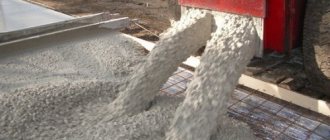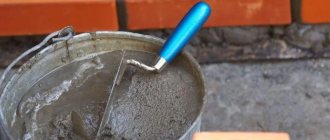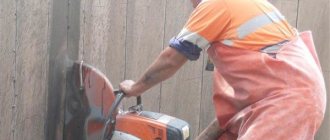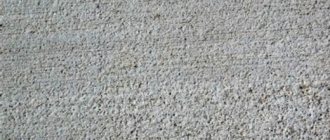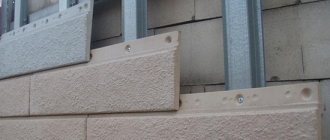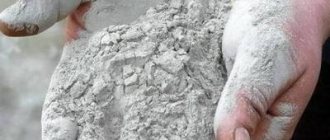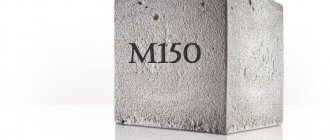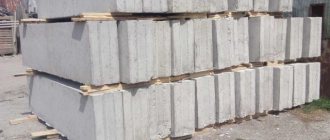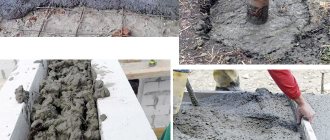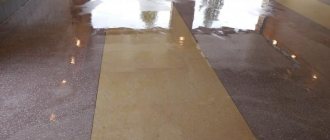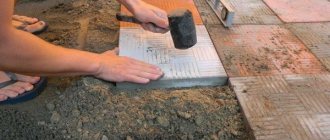What to add to concrete for waterproofing, waterproofing
Concrete is one of the most highly durable building materials. But, it has one significant drawback - low moisture resistance.
The concrete structure has a porous structure, so it quickly accumulates moisture, which leads to a decrease in reliability and durability. To improve waterproofing qualities, special additives are used.
Features of additives for waterproofing
Water-repellent additives are added to the solution to fill voids and displace air . This compacts the concrete and increases its resistance to moisture. The strength properties of the material do not deteriorate.
Such additives typically consist of ferric chloride, silicate glue and calcium nitrate. You can also use the following as additives to improve waterproofing
- salt derivatives of naphthenic acids;
- calcium salts;
- paraffin;
- octadecanoic acid.
After adding additives, a chemical reaction occurs in the solution, changing its structure. In fact, all these substances are mechanical impurities, the key task of which is to increase moisture-proofing characteristics.
Water repellents are also considered to be all impurities that envelop the walls of pores, preventing the penetration of moisture into them. When performing construction and repair work, silicone products are also often used, which contain:
Pool concrete: which brand to choose?
The construction of swimming pools near dachas and country houses has become very popular in recent years. And it is quite natural that most often the material chosen for the construction of the “body” of the pool is concrete. The material is strong, reliable, durable. if only correctly selected and used. But this is how it is - right?
Before answering this question, you need to clearly remember what qualities concrete should have for a pool built in the open air. There are two such qualities:
– water resistance
– frost resistance
In other words, the concrete must be strong enough so that its bottom can withstand the vertical pressure of a considerable mass of water, and the walls can also cope with horizontal pressure (which will inevitably arise when water freezes in winter). At the same time, concrete must withstand at least 100 freezing-thawing cycles (not because it should stand in your dacha for 100 years, but because during the autumn-winter-spring severe frosts are replaced by sudden thaws several times - and 100 of these cycles can accumulate in 20 years, or even less).
It has already been said what concrete can be like - so now we can say that concrete grades M 300 and M 350 are quite suitable for these conditions.
In terms of water resistance, concrete M 300 belongs to class W6 - that is, a 15-centimeter layer of such concrete will withstand, without cracking, a column of water 60 m high. In terms of frost resistance, mortar M 300 belongs to class F 200 - that is, concrete made from it will withstand up to 200 freezing cycles - and at the same time will not lose its qualities.
In general, the concrete is wonderful, all that remains is to prepare it correctly.
In principle, the preparation of the solution can be ordered at the manufacturing plant, but... If you have some equipment, it is better to make it yourself - then you can be sure of the quality of the mixture.
Moreover, it is not at all necessary to make the entire pool from M 300 cement - its bottom can also be made from M100 cement. It is, of course, much inferior to the M300 in terms of water resistance and survives no more than 50 frosts, but... firstly, pools are rarely deeper than 2 meters, and secondly, water almost never freezes at such a depth.
Therefore, the bottom of the pool can also be filled with a mixture of M100, which is obtained from cement grades 500 and 400 in this way, if you measure the components by weight: or volume:
Let’s immediately make a reservation that the data on the weight and volume of water is very arbitrary and how much it will have to be added really depends heavily on the moisture content of the sand.
The calculation for obtaining the M300 mixture looks similar:
It is advisable to take coarse sand (1-1.5 mm), and crushed stone - granite, 10-15 mm in size.
However, one subtlety must be kept in mind - in order to completely fill the body of the pool, you will need at least 10-15 cubic meters of solution and, accordingly, 2-3 tons of cement (that is, from 40 to 60 standard 50-kilogram bags). This amount is quite significant (and quite worth it) and there is a temptation to buy cement gradually and store it “for future use” somewhere in a secluded place.
So - there is no need to do this. During long-term storage, cement will lose its qualities - and in just two or three months, grade 500 in terms of binding properties can turn into 400. So the cement that is used to fill the body of the pool must be “fresh”, since it reliably retains its qualities only 30 days.
Another temptation that arises when choosing concrete is to buy a ready-made dry mixture, then add water - and that’s it. Of course, this approach will reduce the time for making the mixture - but it can also ruin the whole thing, since ready-made mixtures often contain clay and other impurities. In such matters, it is unwise to save on cement.
In addition, you should take into account some features of the soil - if the soil in the places where you are going to build a pool is highly acidic, then it makes sense to add special plasticizers to the cement that increase its resistance to acidic environments.
But here it is impossible to give any general advice - and if such an idea arises, it is better to turn to specialists - including.
INTERESTING ARTICLES
Reinforced concrete stairs
Reinforced concrete stairs are popular in the construction of both residential and industrial buildings. If it is planned that increased pressure will be exerted on the stairs, then it is simply impossible to do without a material such as reinforced concrete.
Design. Electric installation work.
Hello, today we wanted not only to convey to you information about such a design as a staircase made of monolithic concrete, but to show it an absolute advantage among wooden and metal analogues.
Carrying out electrical installation work
Electrical installation work can be organized in different ways, the choice depends on the type of wiring. There is open and hidden wiring.
Concrete pool
Country houses are not uncommon these days, and if you have your own cottage and plot of land, then why not adapt it for other, more pleasant purposes instead of planting potatoes traditionally in Russia?
Sewage installation prices
When a person is building a country house, is going to remodel an apartment, or wants to make an old dacha more comfortable, he is naturally interested in why the prices for sewer installation are exactly what they are and what they consist of?
Pool finishing with wood
Wood, as a finishing material, is usually not very popular when it comes to finishing pools. The arguments against it are well known: wood is susceptible to rotting, and therefore short-lived - and in general.
By choosing us as a contractor, you get a reliable assistant who takes on all the assigned tasks, thereby saving your time!
We work 7 days a week without days off. You can contact us by phone, email or through the contact form on the website.
Monday – Sunday: from 08:00 to 21:00
Pros and cons of water repellents
In addition to waterproofing, such additives have a number of other positive performance qualities:
- increasing strength by compacting the structure of the cement product;
- increasing the service life of the structure;
- saving time on installation;
- reducing the cost of cement raw materials;
- improved cold resistance;
- increased resistance to compression;
- improving the plasticity of the cement-sand mixture;
- prevention of corrosion destruction of reinforced concrete structures.
Special admixtures are also produced that not only fill cavities in the concrete structure, but also swell due to exposure to moisture. Accordingly, if water gets in, the material begins to compact even more, repelling the liquid.
The key disadvantage of waterproofing additives is the reduction in thermal insulation qualities. As a result of filling the pores, the thermal conductivity of the concrete product increases. It is the air-filled cavities that protect against unnecessary heat loss.
If the additive completely removes air from the internal structure, the material begins to retain heat less well. Therefore, when using them, care should be taken to further install the insulation.
Photo: concrete waterproofing
Types of waterproofing additives
into 3 categories according to their release form
- powders added directly to the cement mixture;
- substances that require prior dissolution in water;
- liquid formulations.
Based on functional qualities, the following varieties are distinguished.
Polymer . They improve not only water resistance, but also ductility. They envelop the solution filler (sand, crushed stone, etc.), due to which it repels moisture;
Plasticizing. Resistance to moisture is ensured by the formation of a protective film inside the cavities or the formation of a surface charge on the particles of the added substance. If the second technology is used, polycarboxylate is added. The latter also significantly improves strength properties;
Colmatizing. Significantly increase strength. Moreover, concrete becomes resistant not only to water, but also to various aggressive environments. The pores are filled with fine-grained minerals and soluble substances. When moisture enters the cavities, these substances combine and polymerize, forming solid, dense particles.
Sealants are used to waterproof already hardened cement. But, this is only relevant if cracks form into which moisture can penetrate.
The amount of substance added depends on the composition of the solution and the characteristics of the water repellent itself. In the case of a conventional mixture of cement and sand, about 1 liter of additive is added per 100 kg of solution.
If the solution is based on lime or gypsum, the volume of additive must be reduced by 30%. As a rule, no more than 1 liter of additive . But, you need to take into account the thickness of the structure being formed.
Brands of additives for waterproofing
There are quite a lot of manufacturers producing such products. The most popular brands include “Penetron” and “Crystal”.
These products are optimal in terms of price/quality ratio.
The most popular material used in modern construction. Manufactured (USA). The key advantage is the adaptation of the product to the operating conditions. The more active the moisture is, the more the additive compacts.
Allows you to increase the water resistance of concrete to the highest level - W20. The strength and frost resistance of the structure also increases. Salt protrusions do not form on the surface, so the product can also be used in the construction of decorative products.
Available in powder form. It is added at the rate of 1 kg per 100 kg of cement (not ready-mixed!). The cost of the product starts from 325 rubles. for 1 kg.
Russian-made additive. Also available in powder form. Consists of environmentally friendly raw materials. Added to concrete solution. Improves water resistance to W16 level. For most cases, this indicator is sufficient.
When using the “Crystal”, the strength increases 2 times. Resistance to cold also increases. Efflorescence does not appear on the surface of the structure, so it can be used in finishing. The price of the additive starts from 180 rubles. for 1 kg.
The principle of action of additives: how it works ↑
The effect of additives that increase the water resistance of the composition is aimed at reducing the porosity of the finished material. These substances fill the voids and capillaries that appear in the concrete, compact the concrete and thus prevent water from penetrating into it. Most often, such sealing additives are made from polymers. This method allows you to increase the water resistance of concrete to the level of W8W12.
Please note: The water resistance of concrete can be increased using plasticizers and superplasticizers. They increase the fluidity of the concrete mass, air bubbles trapped in the solution are able to freely rise to the surface, as a result, the porosity of the material is reduced.
Additives begin to concentrate in the pores, preventing the rapid evaporation of moisture, which leads to an increase in the strength of the material
More modern penetrating, crystal-forming hydraulic additives have a more advanced effect, since they help begin the formation of special crystals in capillaries and pores that do not dissolve in water. If, after the structure is ready and the concrete has hardened, water gets into it, these substances begin to swell, filling the voids. As a result, small cracks that appear on the surface of a concrete structure during operation are self-repaired. It should be noted that this is a rather expensive method of waterproofing. If the concrete has sufficient density, this method is not used.
Professional hydraulic additives can increase the water resistance of the composition to the level of W18 - W20. Such compositions are used in the construction of monolithic concrete foundations, swimming pools, water tanks, etc.
Additives to concrete
If earlier in construction they used a classic concrete composition - sand, crushed stone, cement and water, today the requirements for concrete solutions have increased significantly. As well as technologies that make it possible to give it a number of improved qualities.
It should be noted that modern additives to concrete make it possible to very accurately provide the composition with the desired qualities, depending on the area and conditions of its use. In this article we will look at the main additives for concrete , how and why they are used, and why they should be used even in domestic construction or repairs.
Strengthening universal supplement
This is a universal product that improves almost all key characteristics of concrete. It also contains plasticizers, which is why its properties are similar to the plasticizer additives described above.
An important advantage of this additive is its ease of use without the need to use any special equipment. Thus, strengthening additives in concrete can be used independently, without the involvement of specialists. Thanks to this, the additive is often used to create concrete products with your own hands (even beginners can handle this work), for example, borders, garden paths and the like.
Arena BiMix NS/PC, Penetron Admix, Bergauf B-Isol HYDRO PROOF,
HLV-15 increase the strength of the concrete composition by 20-25%
Additives to concrete for waterproofing
Even in the highest quality concrete solution and if all the rules for pouring it are followed, there will still be voids in it. It is simply impossible to avoid this completely without using special additives. And if you leave everything as it is, the empty space will be filled with moisture to one degree or another. Due to the presence of moisture, the strength qualities of concrete are reduced. It will crack and crumble over time. To prevent such a nuisance, concrete additives are used for waterproofing.
Most of these supplements contain the following components:
- silicate glue;
- ferric chloride;
- calcium nitrate.
Compositions based on paraffin, calcium salts and other substances are also used. Such additives actually “clog” the pores of the concrete, seep into it and prevent moisture from penetrating deep into it. In addition, water-repellent additives to concrete provide a number of other positive effects:
- increase the strength of concrete and the density of its structure;
- increase mobility, which in some cases even eliminates the need to use plasticizers;
- significantly increase the service life of the building;
- allow you to achieve water resistance level W;
- protect fittings from corrosion;
- increase frost resistance up to one hundred cycles;
- increase compressive strength up to 30%.
Additives to concrete for waterproofing
To protect concrete products from the harmful effects of moisture, a large number of different methods are used, which prevent its destruction to varying degrees of effectiveness. Additives to concrete for waterproofing are one of the best ways to ensure high-quality and reliable protection of concrete, not only outside, but also inside.
From the article you will learn:
- About water resistance classes of concrete.
- How to increase the water resistance of a concrete structure.
- About the advantages of waterproofing additives in concrete.
- About plasticizers.
- About bridging additives in concrete.
- About waterproofing using polymer additives.
- About liquid glass as a waterproofing additive.
Properties of concrete for a swimming pool
Pool concrete must not only meet the requirements for water resistance, strength and ductility, but also protect the metal frame from the effects of oxygen, chlorine and microorganisms contained in the water. To give the material the necessary waterproofing properties, additives 1DROBETON, SATURFIX or FLUXAN are added to the solution, which increase water resistance and improve the adhesion of concrete to steel reinforcement.
The service life of a concrete pool largely depends on how well the metal frame is protected from corrosion. The higher the density of the material, the more difficult it is for moisture to penetrate into the depths of the structure through capillaries. To prevent the concrete from becoming loose, it is extremely important to strictly adhere to the dosage of water when preparing the solution. In some cases, to ensure good fluidity when pouring, plasticizers are added to concrete, which simultaneously improve waterproofing properties.
Additives to concrete for waterproofing
Depending on the degree of waterproofness of concrete, it is divided into several main classes. The designation of the water resistance class is carried out using the symbol W, followed by a number in the range from 2 to 20. It indicates the degree of increase in moisture resistance in order from lower to higher value. Concrete with a class of four to eight is used for the construction of buildings and structures with an average level of exposure to moisture. When operating in conditions of high humidity or close groundwater , products of class W12 - W20 should be used.
How to increase the water resistance of concrete
The structure of concrete has a porous structure, which allows moisture to fill voids, thereby reducing the performance properties of the finished concrete solution. Moisture that falls on the surface of concrete partially penetrates inside. This process leads to the gradual destruction of the concrete structure. The penetration of moisture is especially dangerous in the autumn period of the year, when concrete saturated with water is subject to sudden temperature changes and water can turn into ice, imperceptibly destroying the concrete product from the inside. Additives to concrete for waterproofing and increasing strength are aimed at reducing porosity. These substances fill all voids formed in the solution, thereby creating a barrier to moisture penetration. Thanks to the use of additives, it is possible to significantly increase the level of water resistance of concrete, which can significantly expand the scope of its application.
The main advantages of waterproofing additives
The main advantages of such additives, their manufacturers include:
- Increasing the service life of concrete products.
- Reducing financial costs associated with external waterproofing.
- Improving the quality of construction work.
A waterproofing additive to concrete is a modern way to improve the water resistance class of concrete at an affordable price. This technology becomes indispensable when arranging a foundation on soil with high groundwater levels, constructing dams, swimming pools, dams and reservoirs, etc.
Types of additives in concrete
Depending on the chemical composition and the basic principle of the effect on the concrete solution, all additives are classified as follows:
- Plasticizers.
- Colmatizing compounds.
- Polymer compositions.
- Liquid glass.
Let's take a closer look at them.
Plasticizers: technology of application and principle of operation
They are substances prepared on the basis of lingosulfate salts. The action of this type of additive is based on increasing the fluidity of the concrete mixture, which allows air bubbles to escape freely. The principle of operation of the substance is based on the formation of an internal electric charge or the formation of a film coating .
To prepare concrete with a plasticizer, it is necessary to add additives to the composition in portions during the process of mixing the solution. The main requirements of this technology are: constant stirring, positive ambient temperature, compliance with proportions.
Advantages of plasticizing additives
The main advantages when using plasticizing additives:
- economical use of cement
- reduction in shrinkage percentage
- no vibration requirements
- increasing the degree of mobility of concrete without reducing its strength.
Operating principle of bridging additives
The main operating principle of this additive is based on a chemical reaction between cement, water and a special substance called micromnesim. Thanks to this chemical reaction, strong insoluble compounds are formed that fill all the voids in the concrete. The method of introducing such additives into the concrete composition is identical to plasticizers.
Advantages of bridging additives in concrete
A waterproofing additive for bridging type concrete has the following advantages:
- reduction in the cost of external waterproofing work
- significant increase in concrete moisture resistance
- increasing the strength of finished products.
Polymer additives in concrete for waterproofing and increasing strength
They make it possible to significantly increase the degree of moisture resistance of concrete mortar due to the formation of a film on its particles. This film seems to glue the particles together, thereby increasing the strength and impermeability of concrete. In addition, polymer compositions improve resistance to mold, fungi and other microorganisms.
Liquid glass: technology and scope of application
It is one of the varieties of silicate glue, which has a positive effect on all the performance characteristics of concrete. During the preparation of the concrete mixture, up to 10% liquid glass is added to the dry concrete mixture, which provides an optimal ratio of performance and cost. Liquid glass is an inexpensive building material.
This additive is widely used in the construction of foundations, boilers, underground reinforced concrete structures, heating boilers and other structures.
The choice of a specific type of additive should be based on an individual approach, taking into account the requirements for the moisture resistance of concrete, its mechanical strength and estimated cost. It should be noted that each supplement is accompanied by instructions for use. To obtain the desired result, you should act according to the manufacturer's instructions.
Proposal of GC SMK for concrete work in St. Petersburg
The SMK group of companies provides a wide range of professional services in the field of construction of facilities using waterproofing additives for concrete. The list of construction work we carry out includes the arrangement of the most complex objects:
- Concreting of sites , foundations ( strip , slab, etc.).
- Ground floors.
- Floor screed.
- Monolithic walls.
- Floor slabs.
- Concrete floors.
- Steps/stairs.
- Load-bearing columns.
Our qualified personnel know and are able to use in practice the manufacturing technology of adding additives to obtain moisture-resistant concrete. All our work comes with a long warranty. Call or write to us using the contact information provided in the “ Contacts ” section. Our managers will offer the optimal solution for the most complex and non-standard tasks in St. Petersburg and the Leningrad region.
Blog
- The pool bowl must be independent, i.e. not tied to the walls and foundation of the building.
- The recommended class of concrete for compressive strength is not lower than B25 (or concrete grade - M350 in the old designation). For indoor pools, the grade of concrete for water resistance is - For outdoor pools, the grade of concrete for frost resistance is F200, for water resistance - W6.
- All external surfaces of the pool bowl in contact with the ground must be protected with waterproofing. The bottom of the pool bowl should be above the groundwater level. If the groundwater level is high, measures must be taken to lower it.
- The walls and bottom of the pool must consist of double reinforced concrete. To do this, 2 layers of reinforcement with a diameter of 12 mm are connected with a cell of 20-25 cm. Between layers of reinforcement there is 10 cm. The thickness of the bottom and walls of the pool bowl should be at least 20-25 cm.
- Preparing the bottom of the pool: fittings are tied with an outlet on the walls. Filling the bottom of the pool is carried out taking into account the fact that the clean bottom (tiles, mosaics) of the pool must be flush with the surface of the bottom drain. In NO less than 3 days, the installation of reinforcement in the walls begins.
- For walls: reinforcement is tied, formwork is installed and concrete is poured. NO less than 3 days later, the formwork is removed and the bowl is leveled.
- When constructing the walls of the pool bowl, it is necessary to seal cold and structural seams and joints using a hydrophilic rubber profile (for example, “Hydrotite”).
- The upper edge of the bowl (side) must be made at the water level, strictly horizontal (deviation from the horizontal is no more than 1 mm per 1 m of length) in accordance with SNiP 3.04.01-87.
- When pouring the pool walls, it is necessary to provide holes for the embedded parts. The installation locations and hole sizes are indicated by the pool installation specialist.
- It is recommended that the geometric dimensions of the pool and its elements (steps, etc.) take into account the whole number of rows of tiles or mosaics, including the seams between them.
- Plastering the inner surface of the pool bowl must be carried out taking into account the following requirements:
- The plaster must have strong adhesion to the concrete of the bowl along the entire plane. The presence of voids between the plaster and the concrete of the bowl is not allowed.
- Plaster mixtures must be cement-based.
- If the plaster thickness is more than 30 mm, it must be applied over a mesh securely attached to the concrete of the bowl
- The walls over the entire surface must be smooth (no more than 2 irregularities are allowed per 4 m2 of surface with a height (depth) of up to 1 mm and strictly vertical (vertical deviations should not exceed 1 mm per 1 m) according to SNiP 3.04.01-87
When plastering the bowl, it must be left for several days before work on installing the embedded parts is carried out.
- Installation of embedded parts is carried out after leveling the walls of the pool. When installing embedded equipment elements, it is recommended to use special waterproofing materials (Hydrotite cord and Mapefil anchor compound to fill holes).
- After installing the embedded parts, if the pool bowl is planned to be covered with tiles/mosaics, it is necessary to carry out waterproofing work. If the pool is planned to be lined with a film (liner) and the air temperature outside or in the room where the pool is installed is above +15 degrees, then the film (liner) can be cooked.
- Internal waterproofing of the bowl should be done with cement-based waterproofing materials (in accordance with the instructions for using the materials).
- After internal waterproofing is completed, the pool bowl should be completely filled with water and left for at least 14 days in order to detect leaks, after which the water should be drained and the bowl should be thoroughly dried.
- When laying tiles or mosaics in an outdoor pool, it is necessary to install a canopy to prevent rainwater from entering the pool bowl. The ambient temperature during installation should be in the range of +10 – +40 degrees, in accordance with the instructions for the materials used. When carrying out work on waterproofing the pool bowl or laying tiles or mosaics, it is prohibited to carry out other work in or above the pool bowl.
- The laying of pipelines in the ground must be carried out in accordance with SN-478-80 (1990). The soil at the base of the pipe under the PVC pipe and for the filling should not contain brick, stone or crushed stone. When backfilling PVC pipelines, a protective layer 30 cm thick of soft local soil that does not contain solid inclusions (crushed stone, brick, stones, etc.) should be provided above the top of the pipeline. In this case, the use of manual and mechanical tampers directly above the pipeline is not allowed.
- In open pools, in order to avoid destruction of pipelines as a result of freezing of water in them:
- it is necessary to provide for the possibility of draining water from the pipeline and equipment when preserving the pool for the winter
- All external pipelines laid in the concrete of the bowl or soil are recommended to be made of semi-rigid pipes or reinforced hose.
Requirements for installation of filtering equipment and electrical equipment.
- Strapping F.O. It is carried out only in a separate room, which must be dry, clean, heated.
- Electricity, water, and sewerage must be provided to the installation site of the equipment.
- If a heat exchanger is provided during equipment installation, 2 pipes are required to connect it to the boiler.
- All electrical circuits of the pool must be equipped with a protective circuit breaker and have a ground loop.
- The cross-sectional area of electrical wires must comply with the specified instructions for the equipment.
Additives to concrete and their types
Concrete mortar is used for constructing structures that are characterized by strength, hardness and endurance (paths, floors, walls, foundations). Depending on the operating conditions of the resulting dry residue, components are added to the finished mixture of cement, sand and water that enhance certain indicators.
As a result, the service life of the finished result increases.
What concrete additives do experts recommend?
Penetron Admix
Among the popular additives to concrete, it is worth noting the dry mix Penetron Admix. This is an environmentally friendly material, non-toxic. Thanks to certification, the scope of application extends to social institutions (hospitals, schools, swimming pools). It is also allowed for the construction of drinking water reservoirs.
The composition is used both at the construction stage and in repair activities. The product has the ability to penetrate deeply into the structure of concrete and fill micropores, cracks and small defects with crystals. If you need to increase frost resistance and strength, then Penetron Admix behaves inertly to other additives, that is, it does not lose its quality characteristics.
Additives are added at the factory or independently. The dosage in dry form in relation to cement is 1 to 100 (4 kg/cubic meter of concrete). It is added to the solution diluted with water (1.5 to 1) for 5 minutes.
It is imperative to work with gloves and construction glasses. In case of contact with skin or eyes, rinse with plenty of running water. Otherwise, the rules are consistent with the technology regarding concrete mortar in general.
Calmatron
Kalmatron concrete additive is attractive in terms of price and quality. This product both increases and restores the waterproofing properties of the concrete surface. By filling the pores, the frost resistance and strength of the structure also improves. It is worth noting the availability of the material in conditions of acids and alkalis with a balance of 3 to 11.
The company's assortment is represented by the following materials:
- Calmatron-Elastic. A two-component cement-based mixture gives the mortar plasticity. The environmentally friendly composition is allowed for the construction of swimming pools and drinking water reservoirs.
- Hydroconcrete SRG-1 and SRG-2. Suitable for work during the construction and repair of concrete structures. Strengthens, seals, insulates the surface. The seams are insulated. All this is possible thanks to inorganic compounds that are formed after a chemical reaction of additive substances with concrete molecules.
- Kalmatron-D. Increases water resistance, extends frost resistance to 50 cycles. Concrete with such an additive or surface treatment is resistant to acids, alkalis, and phosphates.
Despite the environmental friendliness, when working with materials, it is necessary to protect the skin and mucous membranes. For this, gloves, goggles and a respirator are used. If contact occurs, you can wash it off with running water.
The Poliplast company produces various additives for concrete. All products are manufactured in accordance with GOST standards and certified. In particular:
- plasticizers for fluidity;
- setting retarders and accelerators;
- modifiers for frost resistance.
It is also worth noting biocidal chemical additives for concrete. They are designed to prevent the formation of foci of biological damage to structures (fungus, mold). The scope of application of Polyplast products extends to the private, industrial sector and marine buildings and equipment.
The most popular superplasticizer is Poliplast SP-1. It is made in the form of a dry mixture or liquid. It is designed to increase the fluidity, impermeability, density, and strength of concrete. At the same time, cement consumption is reduced.
Relamix is used to speed up the development of strength. To reduce mobility, you need to use Linamix. This is especially true in hot weather or when transporting the solution over long distances.
If high levels of water resistance, frost resistance (up to 400 cycles) and crack resistance are required, then for this you will need a PFM-NLC modifier. And for winter work at temperatures down to -25℃, you can take Cryoplast P-25.
Concrete additives from Sika can be used to improve any concrete characteristics. For example, Antifreeze FS-1 is used to accelerate the setting of the solution and give it frost resistance. SikaPlast-520 allows you to plasticize concrete and reduce the setting speed.
Also in demand:
- Liquid Latex for elasticity when installing thin-layer screeds, improving adhesion and tensile strength;
- Sikament BV 3M is often used to level heated floors. That is, the additive improves thermal conductivity and density, and reduces the coefficient of thermal expansion.
- 1 Plus is aimed at water resistance and maintaining vapor permeability. This reduces the risk of efflorescence formation.
The reinforcing additive is fiber fiber (12 mm) made of 100% polypropylene without olefins SikaFiber PPM-12. Widely used for constructing load-bearing structures, walkways, fire-resistant walls and floors, and tanks. You can also choose waterproofing and strengthening additives, pigments with water-repellent properties.
Properties of additives
Waterproofing mixtures penetrate into all pores of concrete and significantly increase its service life.
- When using the additive, preliminary drying of the surface to be treated is not required. The solution should be applied to a well-moistened surface. Thanks to this property, construction time does not increase.
- There is no need for special (complicated or lengthy) surface preparation.
- In application, the compositions of deep penetration additives are very simple and have simple instructions for use.
- The use of these impregnating materials is effective in the same way both on the outside of the wall and on the inside and does not depend at all on the direction in which the water is exposed.
- Thanks to the use of waterproofing additives, the grade of the building material increases in terms of strength and waterproof indicators. In addition, frost resistance also increases.
- In case of mechanical damage, all the waterproofing properties of the material are preserved due to the resumption of growth of polymer crystals (self-healing ability occurs).
- The service life of waterproofing additives is equal to the service life of the entire structure, that is, the particles act continuously and do not lose their waterproofing properties.
- Treated concrete acquires increased resistance to aggressive environmental influences. At the same time, vapor permeability is maintained. Some waterproofing compounds are even used in storage drinking systems.
- Thanks to waterproofing additives, the corrosion resistance of metal structural elements (reinforcement) increases. They can be used even with increased hydrostatic water pressure.
- Additives for waterproofing are environmentally friendly and non-toxic.
